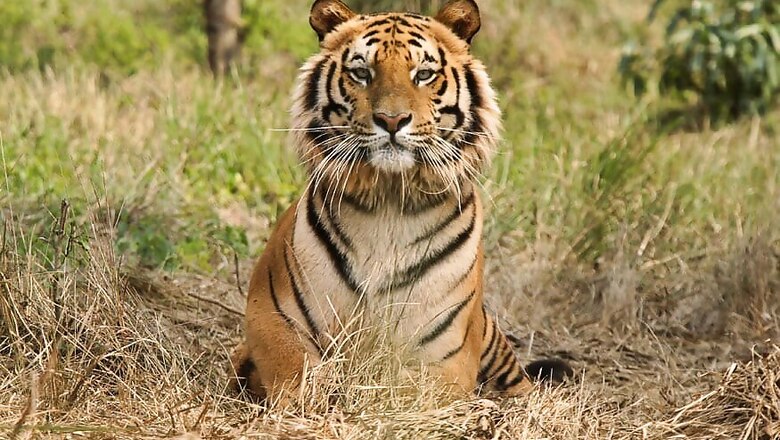
views
Uttarakhand: Rejecting the Uttarakhand forest department’s explanation of the death of 40 tigers and 272 leopards in the state in 18 months, the Uttarakhand High Court has directed the Central Bureau of Investigation (CBI) to probe the possible nexus between the department and poachers.
The forest department had cited the Darwinian theory of ‘the survival of the fittest’ to explain the killings.
The Division Bench of Acting Chief Justice Rajiv Sharma and Justice Lok Pal Singh asked the investigating agency to conduct a preliminary enquiry into all the cases of poaching in the state and to ascertain the “complicity”, “involvement”, “connivance” or “collusion” of serving officers or officials of the forest department in the past five years.
The state’s record with big cat mortality is among the highest in the country and originates from the case of five tigers killed by poachers in 2016 in India’s premier tiger reserve, the Jim Corbett National Park and the alleged cover-up by the state officials that followed. The park is the oldest in the country and was the first reserve to come under the ambit of Project Tiger. It also has the highest tiger density in the country.
Poachers moved freely during the day
On March 14, 2016, the Uttarakhand police’s Special Task Force (STF) in Haridwar seized five tiger skins and 125 big cat bones while two alleged poachers were suspected. A report submitted by the National Tiger Conservation Authority (NTCA) to the Uttarakhand High Court said that the poachers had moved freely during the daytime, killing the big cats without fear of surveillance or arrest.
“Nearly an 8km stretch between Kalagarh and Lansdowne on the western side of Corbett is unmanned, and there are no watch towers, no camp and no surveillance on intrusion of outsiders,” said the report, submitted by DP Bankhwal, inspector general of forests, NTCA.
What this meant was any poacher who entered the protected forest from the Lansdowne division or from the border of the two divisions inside the forest could “kill tigers and other wild animals without fear of being caught or detected,” the NTCA concluded.
It was no accident that in the first four months of 2016, more tigers had been poached than in the entire 2015, with data from the Wildlife Protection Society of India (WPSI) showing that 28 tigers had been poached till May 1 – compared to the 25 recorded kills in the earlier year.
Disappearing evidence
The evidence in the case included spears, bones, blood-stained clothes, polythene bags and salt bags. These had been collected by Rajeev Mehta – who heads the trust, ‘Operation Eye of the Tiger-India’. These were handed over to former Uttarakhand Chief Wildlife Warden Digvijay Singh Khati.
On June 28, earlier this year, the Uttarakhand Principal Chief Conservator of Forest Jai Raj, submitted a report to the government that instead of conducting an enquiry into the case, the evidence disappeared. “It appears that on his intimation the evidence was made to disappear. This proves his criminal intent,” the report said.
Khati then went on to submit a report to the government maintaining that the poaching incident hadn’t taken place in the state boundaries, but the adjacent areas of Uttar Pradesh. Jai Raj’s report disputed that and said that as per the Wildlife Institute of India at least four of the tigers had earlier been photographed at the Corbett Tiger Reserve.
“If tiger poaching takes places either inside or outside a reserved area, the responsibility falls on the chief wildlife warden,” the report said, and accused both Khati and the administration at the forest reserve of having “disowned” the incident. Apart from Khati, the report also pinned the blame of “administrative laxity” on divisional forest officers at Kalagarh and Lansdowne areas and the former director of the park, Samir Sinha.
The Uttarakhand High Court on Tuesday also noted that “ a few officers/officials of the Haridwar Forest Range were merely transferred when they were found involved in destruction of evidence instead of taking a stern action against them”. Noting that “sufficient material has come on record” to suggest collusion, the court asked the CBI to “hold preliminary enquiry into all the cases of poaching in the State of Uttarakhand” and to find “the complicity/involvement/ connivance/ collusion of the serving Officers/ Officials of the Forest Officers/officials in the last 5 years” and asked for the report to submitted in three months.
The shrinking buffer around Corbett’s core
Not just poaching, the court also noted the risk to the tiger reserve due to the shrinking forest in the 10-km buffer area, meant to protect the tigers from poaching and also cases of man-animal conflict. Two instances were flagged: one pertaining to the actual scope in terms of lost forest cover and the other a village that no one knew about.
The first issue pertained to a study conducted by Dr Prayag Madhukar Dhakate, chief conservator of forests (western circle), and Shah M Belal, a scientist in the Uttarakhand forest department. The study found that from 1990 to 2015, forest cover in the buffer area of the reserve had shrunk from 55 per cent to 43 per cent. The human settlements increased from over 4 per cent to 9 per cent, agricultural area from nearly 26 per cent to 31 per cent and that human population density was more than the national average.
The study was based on remote-sensing data on changes in land use, but its veracity was doubted by the State government in court. The court noted that there was “variance in the findings recorded” in the study and calculations done on the basis of the Forest Survey of India. The court referred the issue to the NTCA to “determine the forest loss in southern boundary of Corbett Reserve Forest” within six months.
The second issue was that of a village called Sundarkhal, “which falls in the buffer zone, but till date, the villagers have not been removed”. The court noted that “a majority of the forest officers were ignorant of the name of the village” and directed that “all necessary steps to remove the encroachers from the buffer zone Sundarkhal opposite Dhangari Gate within one month.”
The court also banned the entry of private or commercial gypsies to ply in Dhikala Zone of the reserve, thereby modifying the previous order of permitting 32 vehicles each to ply in Jhirna as well as in Birjani Zones.



















Comments
0 comment